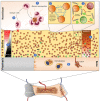Antibiotic Tolerance of Staphylococcus aureus Biofilm in Periprosthetic Joint Infections and Antibiofilm Strategies
- PMID: 32867208
- PMCID: PMC7558573
- DOI: 10.3390/antibiotics9090547
Antibiotic Tolerance of Staphylococcus aureus Biofilm in Periprosthetic Joint Infections and Antibiofilm Strategies
Abstract
The need for bone and joint prostheses is currently growing due to population aging, leading to an increase in prosthetic joint infection cases. Biofilms represent an adaptive and quite common bacterial response to several stress factors which confer an important protection to bacteria. Biofilm formation starts with bacterial adhesion on a surface, such as an orthopedic prosthesis, further reinforced by matrix synthesis. The biofilm formation and structure depend on the immediate environment of the bacteria. In the case of infection, the periprosthetic joint environment represents a particular interface between bacteria, host cells, and the implant, favoring biofilm initiation and maturation. Treating such an infection represents a huge challenge because of the biofilm-specific high tolerance to antibiotics and its ability to evade the immune system. It is crucial to understand these mechanisms in order to find new and adapted strategies to prevent and eradicate implant-associated infections. Therefore, adapted models mimicking the infectious site are of utmost importance to recreate a relevant environment in order to test potential antibiofilm molecules. In periprosthetic joint infections, Staphylococcus aureus is mainly involved because of its high adaptation to the human physiology. The current review deals with the mechanisms involved in the antibiotic resistance and tolerance of Staphylococcus aureus in the particular periprosthetic joint infection context, and exposes different strategies to manage these infections.
Keywords: Staphylococcus aureus; antibiotic; biofilms; periprosthetic joint infections; resistance; tolerance.
Conflict of interest statement
The authors declare no conflict of interest.
Figures



Similar articles
-
Genomics of Staphylococcus aureus and Staphylococcus epidermidis from Periprosthetic Joint Infections and Correlation to Clinical Outcome.Microbiol Spectr. 2022 Aug 31;10(4):e0218121. doi: 10.1128/spectrum.02181-21. Epub 2022 Jun 28. Microbiol Spectr. 2022. PMID: 35762769 Free PMC article.
-
Antibiotic-loaded synthetic calcium sulfate beads for prevention of bacterial colonization and biofilm formation in periprosthetic infections.Antimicrob Agents Chemother. 2015 Jan;59(1):111-20. doi: 10.1128/AAC.03676-14. Epub 2014 Oct 13. Antimicrob Agents Chemother. 2015. PMID: 25313221 Free PMC article.
-
Staphylococcus aureus Aggregates on Orthopedic Materials under Varying Levels of Shear Stress.Appl Environ Microbiol. 2020 Sep 17;86(19):e01234-20. doi: 10.1128/AEM.01234-20. Print 2020 Sep 17. Appl Environ Microbiol. 2020. PMID: 32709721 Free PMC article.
-
Current treatments for biofilm-associated periprosthetic joint infection and new potential strategies.J Orthop Res. 2022 Jul;40(7):1477-1491. doi: 10.1002/jor.25345. Epub 2022 May 6. J Orthop Res. 2022. PMID: 35437846 Free PMC article. Review.
-
Biofilm in implant infections: its production and regulation.Int J Artif Organs. 2005 Nov;28(11):1062-8. doi: 10.1177/039139880502801103. Int J Artif Organs. 2005. PMID: 16353112 Review.
Cited by
-
Lactobacillus rhamnosus and Lactobacillus casei Affect Various Stages of Gardnerella Species Biofilm Formation.Front Cell Infect Microbiol. 2021 Feb 19;11:568178. doi: 10.3389/fcimb.2021.568178. eCollection 2021. Front Cell Infect Microbiol. 2021. PMID: 33680986 Free PMC article.
-
Adaptive antimicrobial resistance, a description of microbial variants, and their relevance to periprosthetic joint infection.Bone Joint J. 2022 May;104-B(5):575-580. doi: 10.1302/0301-620X.104B5.BJJ-2021-1759.R1. Bone Joint J. 2022. PMID: 35491584 Free PMC article. Review.
-
Tetracycline and Oxacillin Act Synergistically on Biofilms and Display Increased Efficacy In Vivo Against Staphylococcus aureus.Curr Microbiol. 2024 Nov 6;81(12):447. doi: 10.1007/s00284-024-03959-4. Curr Microbiol. 2024. PMID: 39505760 Free PMC article.
-
Antibiotic Therapy for Prosthetic Joint Infections: An Overview.Antibiotics (Basel). 2022 Apr 5;11(4):486. doi: 10.3390/antibiotics11040486. Antibiotics (Basel). 2022. PMID: 35453237 Free PMC article. Review.
-
Efflux pump inhibitor combined with ofloxacin decreases MRSA biofilm formation by regulating the gene expression of NorA and quorum sensing.RSC Adv. 2023 Jan 19;13(4):2707-2717. doi: 10.1039/d2ra06696c. eCollection 2023 Jan 11. RSC Adv. 2023. PMID: 36741169 Free PMC article.
References
-
- Reffuveille F., Josse J., Vallé Q., Gangloff C.M., Gangloff S.C. Staphylococcus aureus Biofilms and their Impact on the Medical Field. Rise Virulence Antibiot. Resist. Staphylococcus Aureus. 2017;11:187. doi: 10.5772/66380. - DOI
Publication types
LinkOut - more resources
Full Text Sources

